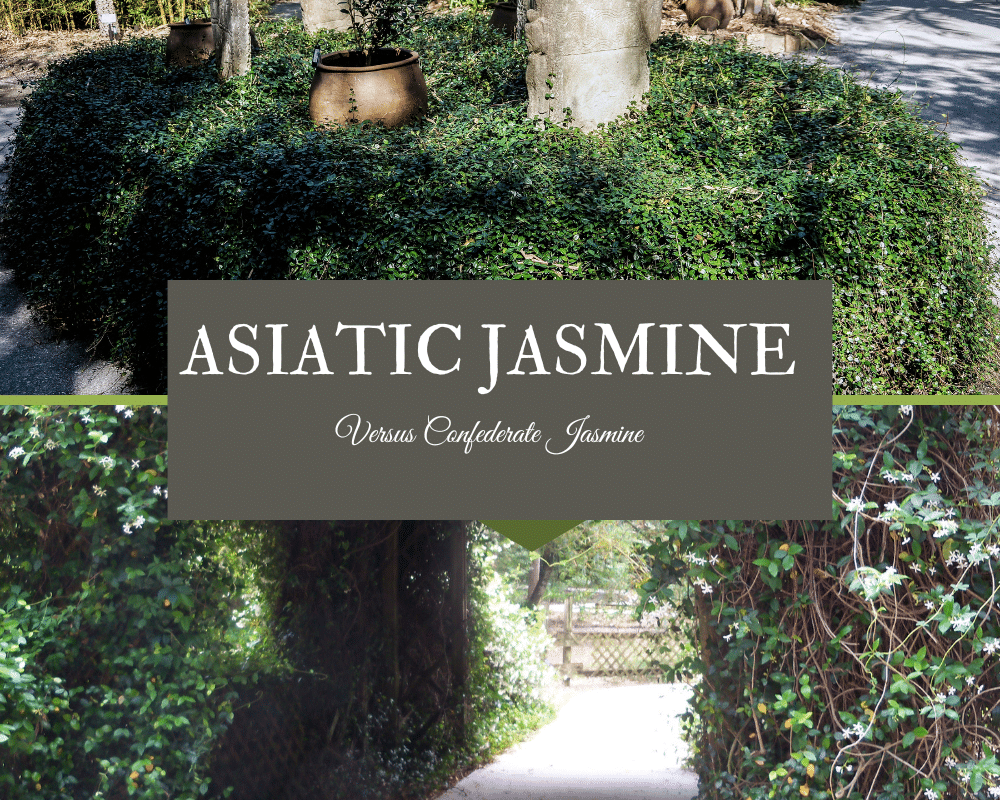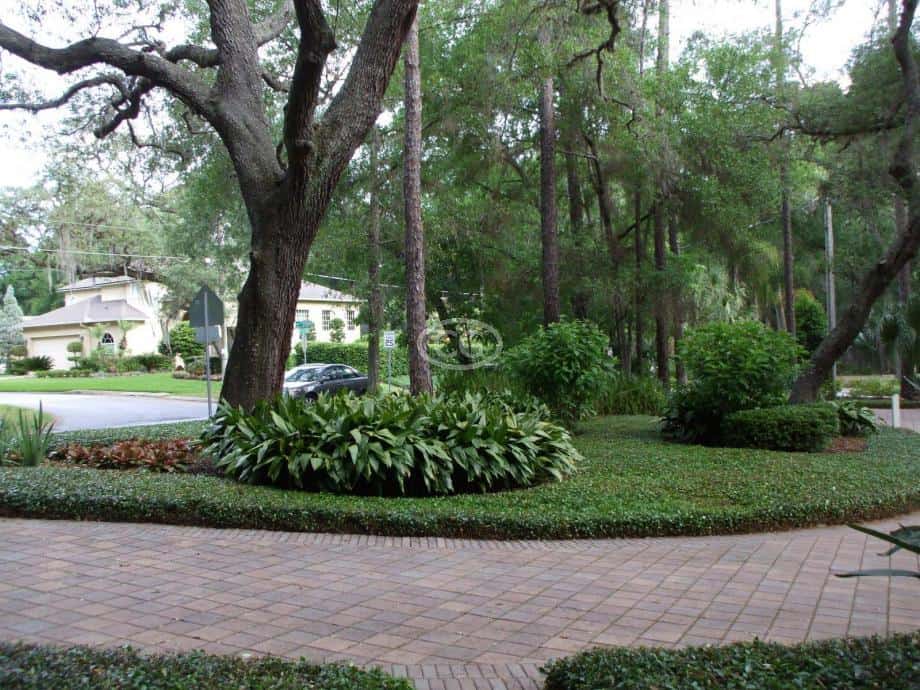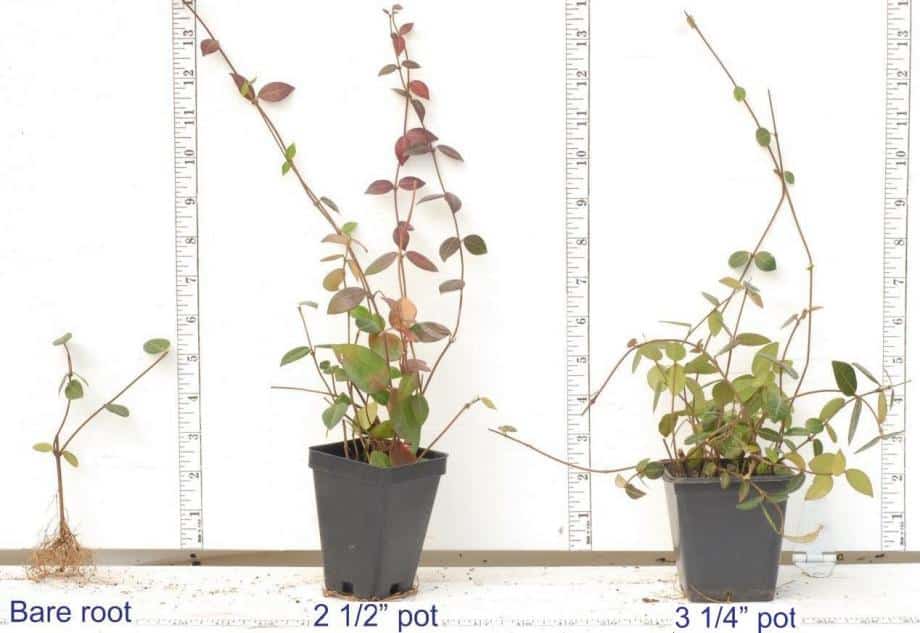What Are Its Features?
Trachelospermum asiaticum-(track-ul-oh-SPUR-mum-ay-zee-AT-ih-kum)
Asiatic Jasmine is a beautiful green ground cover. Evergreen and vine-like, it is a woody plant that provides a dense, solid, green ground cover. The plant is made of tiny, leathery, bright leaves and wiry reddish-brown stems. When mature, it presents a solid green carpet that can exceed 6″ high. It is relatively indifferent to types of soil and the amount of sunshine. It is happiest in healthy soil and part sun but will accommodate many locations in zones 7-10.
We have planted it in many places that run from sun to shade and incorporate poor soil, including tree roots. It is a dependable performer.
What Asiatic Jasmine Is and Is Not
Asiatic Jasmine is one of horticulture’s odd naming conventions. To start, it is not true jasmine and bears the name because it can produce scented jasmine-like flowers.

The plant is related to Tracelospermum jasminoides, called Confederate Jasmine; also not a jasmine but a beautiful plant with scented white flowers and shiny dark leaves. The major difference for us gardeners is that Tracelospermum jasminoides is a climbing plant, and Asiatic Jasmine is happy to cover the soil and doesn’t climb.
Where Can I Use Asiatic Jasmine
Use this lovely ground cover in zones 7-10. Within those zones, Asiatic Jasmine is remarkably accommodating, as it grows in sun or shade as well as on slopes or flat ground. In addition, it tolerates a wide range of soil conditions. It will grow in any soil that is not constantly wet.
Note how the plant grows, below; it makes an excellent plant to control erosion.
How It Grows
You start with individual spreading plants that slowly extend across the ground and form a dense, thick, and tangled cover for the soil. It will create a blanket-like, attractive dark green and shiny covering. It is a desirable alternative to turf in areas where turf does not grow successfully. Note in the photo below how it adds interest under trees.
If your spot requires color, the plant is available in variegated varieties.
This is a highly adaptable plant. When you need to cover large areas, it is helpful to have something so cooperative!
How Can I Use Asiatic Jasmine To Solve Problems In The Garden

Asiatic Jasmine can enhance your property’s beauty and solve significant problems.
- Provide an expanse of green in places where turfgrass will not grow.
- Cover hard-to-mow spaces and slopes with a green cover.
- Enhance green monotone areas with a unique shine and texture. It will make the most of mass planting areas.
- Create height. For example, use three green steps: Turfgrass, at about 4 inches. Jasmine at 6″+. Then Dwarf Boxwood at 12″+, then some flowering plants or bulbs
- Use to edge a border of liriope. Consider the green with the dramatic black liriope.
- To surround a tree with solid green-even in places where turfgrass will not grow
- Surround and set off islands of flowering plants and small trees.
- Extend the day by having garden lighting rise through it
- Surround and set off garden art and water features
- Form a spiller in a container, window box, or hanging basket, or use it as a topiary
- Surround stepping stones and walkways.
- Sidewalk medians where turf grass fails
- Reduce erosion on hillsides
Where Did It Come From?-How Did We Get It?
This handy groundcover hails from Asian countries, including Japan, Korea, Southern China, and Vietnam. A German botanist named Phillip Franz von Siebold saw it on a trip to Japan sometime between 1823-29. By 1846, he wrote about it in Western literature. It is winter hardy in zones 7-10. In Florida, we use it in both sun and shade locations. Find your USDA Plant Hardiness Zones. The plant is also salt tolerant, which contributes to its popularity in our coastal community.
How Do I Buy It

I can find it in Florida in many garden centers and through online dealers. Because it is a plant we use a lot of (to cover large spaces), it is important to find healthy plants at reasonable prices.
Asiatic Jasmine is a spreading plant. Each one covers as much as 3′ in width, but it is slow to start. Pretty, healthy…but slow. We can buy plants in two ways.
Rooted plants in small pots in soil. Treat them like any new plant.
Bare root plants will grow as well as others, but they are small and take a little longer to grow, which is reflected in the price. Consider your time requirements.
If I have big long-term plans for the garden and plenty of time to implement them, I’ll use bare-root plants. I have used plants like Asiatic Jasmine or Mondo Grass this way. The really small ones I plant in soft soil with a fat pencil to make the holes. It’s quick and easy. Who knows? Perhaps an idea for the great American novel will come to me; I can set it down on the wrapping paper!
Do you have a big event coming in a few months or so? If I plan to sell the house or perhaps I have a wedding reception ahead, I will use the small pots to compress the time to maturity.
How Many Plants Do I Buy
Here is a handy plant calculator. This should save you time and money by ordering the right amount! The plant will, at maturity, reach at least three feet wide and about six to eighteen inches high.
Asiatic Jasmine Care

How Do I Prepare the Soil And Plant Them?
Soil Preparation: Work organic matter into the soil. Use peat moss, compost, or manure. Spread 2″-4″ of the organic matter into the soil, digging down 6″-12″, loosening the soil as you work.
Remove weeds in the area you will plant. You can hand weed or use a chemical weed remover. Read the instructions on the label.
Asiatic Jasmine will grow in acid to slightly alkaline soil with a pH ranging from 5.5 to 7. (Average garden soil ranges from 6.0-7 on the pH scale.)
Planting: If planting from the grower’s pots, make the holes two times the size of the pot. If using the bare-root plants, make a 3″ hole.
Light Conditions
We in southern gardens value Asiatic jasmine for its ability to cover areas with both sun and shade. This allows us to landscape with it in and around trees, an otherwise difficult place to plant.
Fertilizer and Water
- When planting, fertilize with a balanced 10-10-10 fertilizer.
- In early spring, add a high nitrogen fertilizer, 16-4-8, every 4 to 6 weeks.
- In early fall, return to the balanced feed, 10-10-10.
Soil and Soil pH for Asiatic Jasmine
The plant will not perform successfully in extremely and constantly wet soil. Other than that caveat, it is tolerant of a variety of soils.
Asiatic Jasmine performs best in a soil pH of about 5.5 to 7. (Average garden soil ranges from about 6-7.)
Water: upon planting, soak the new plants thoroughly to saturate the new roots. Keep the plants moist for the first few months while the plants are being established.
Maintenance
Asiatic Jasmine is vigorous, quite drought tolerant, and resistant to pests and diseases. Once established, trim the edges 2-3 times per year. Keep the height about 4″-6″ tall for a smooth, full look. This is an infrequent task, and a string trimmer works well for the job.
Are They Invasive?
Having used these for many years, I was surprised to find this complaint. We used them near trees where turf would not grow and loved them. The plantings were very low maintenance and never invaded the adjacent grass or the flower beds. We kept them trimmed. Around trees and shrubs, we trimmed them away from the other plant.
You should enjoy years of low-maintenance pleasure from this ground cover.
To learn more, click the banner below.

Classy Groundcovers offers free shipping on quality groundcovers.
Reference Materials
“How to find a Low Maintenance Ground Cover we Love and the Rabbits do Not”
“Solve Ten Problems with Groundcover.”
